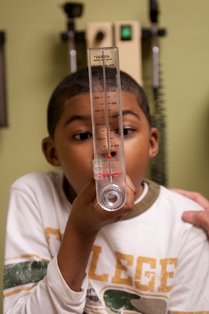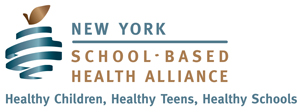Asthma is a leading chronic illness among children and adolescents. It is also one of the leading causes of school absenteeism. On average, in a classroom of 30 children, about 3 are likely to have asthma. Low-income populations, minorities, and children living in inner cities experience more emergency department visits, hospitalizations, and deaths due to asthma than the general population.
How School Based Health Centers Help Manage Asthma
School-based health centers (SBHCs) help children, youth, and families manage asthma, keeping kids out of the hospital and in school and saving money for our health care system. More specifically, recent research shows that:
- SBHC users are less likely to have asthma-related restricted activity days
- SBHC users miss less school as a result of their asthma
- SBHC users are less likely to go to the ER or be hospitalized for asthma
- When children with asthma have access to an SBHC, less is spent on ER visits and hospitalizations

Asthma Friendly Schools
Asthma-friendly schools are those that make the effort to create safe and supportive learning environments for students with asthma. They have policies and procedures that allow students to successfully manage their asthma.
- Establish strong links with asthma care clinicians to ensure appropriate and ongoing medical careTarget students who are the most affected by asthma at school to identify and intervene with those in greatest need
- Get administrative buy-in and build a team of enthusiastic people, including a full-time school nurse, to support the program
- Use a coordinated, multi-component and collaborative approach that includes school nursing services, asthma education for students and professional development for school staff
- Support evaluation of school-based programs and use adequate and appropriate outcome measures
Why Use Open Airways in the Schools
The American Lung Association, the National Asthma Education Prevention Program (NAEPP), the Environmental Protection Agency and other asthma experts have all recognized that asthma management education is an important part of making schools asthma-friendly. The Centers for Disease Control and Prevention recommends that all schools provide asthma education programs for students and school staff.
Open Airways for Schools is the most widely recognized asthma management program for children in the nation. Since being introduced over a decade ago, Open Airways for School has reached hundreds of thousands of children with asthma in more than 40,000 elementary schools across the country.
The program has been approved and recommended by the National Association of School Nurses, and honored with a Health Education Research Award from the National Asthma Education Prevention Program (NAEPP). It has also been cited by the Centers for Disease Control and Prevention as a program proven to be very effective for childhood asthma management.
The Open Airways for Schools program has been evaluated and proven effective. Evaluation studies done by different researchers over the years have all shown that children who participate in Open Airways for Schools:
- Have fewer and less severe asthma attacks
- Improve their academic performance
- Have more confidence in their ability to take steps to manage their asthma
- Exert greater influence on their parents’ asthma management decisions
- Decreased absenteeism
- Fewer asthma emergencies
- Improved classroom performance
- Increased participation in physical activity
- Low-cost, turn-key program materials and training
- Access to the resources and support of the American Lung Association
Asthma Handouts and Templates
- Urban school-based asthma treatment cost effective (JAMA, 2017)
- SBHC Asthma Guide 2015
- Provider Asthma quick reference guide
- Solutions for Physical Education on High Ozone Days
- Strategies for Addressing Asthma Within a Coordinated School Health Program – CDC
- ALA Open Airways for Schools Handout – English and Spanish
- Fit Kids Activity Plans: Straws Poster Meter Role-Play Exercising Wheel of Fortune
- Kickin’ Asthma Student Workbook – English and Spanish
- Parent Letter – English and Spanish
- University of Michigan Asthma Quality Management Plan
